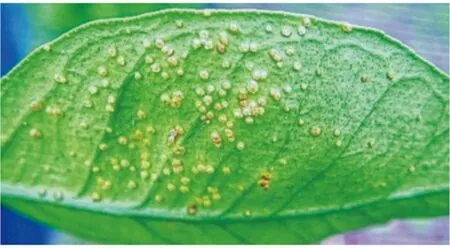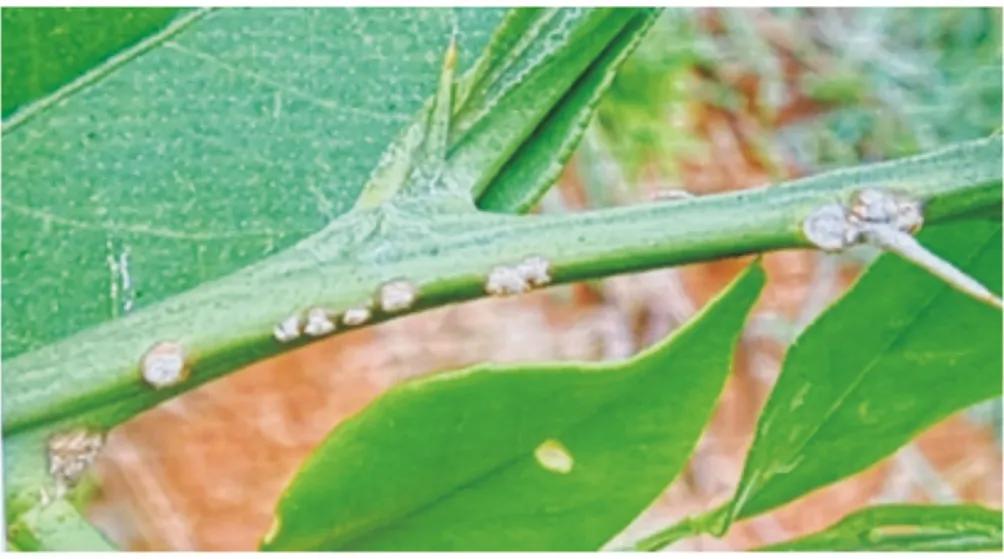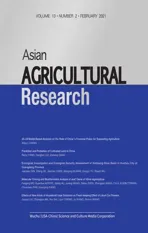Occurrence Regularity and Integrated Control Technology of Canker in Citrus
2021-04-08ZhijingWANGLimingWUFangSONGLigangHECeWANGYingchunJIANG
Zhijing WANG, Liming WU, Fang SONG, Ligang HE, Ce WANG, Yingchun JIANG
Institute of Fruit Tree and Tea, Hubei Academy of Agricultural Sciences, Wuhan 430064, China
Abstract Canker is a quarantine bacterial disease that seriously harms leaves, branches and fruits of citrus, leading to a decrease in the production and affecting the commodity and sales of citrus. Citrus canker has the characteristics of fast spreading speed and difficult radical cure. Through the identification of symptoms and a summary of occurrence regularity, the integrated prevention and control technology for citrus canker is described in this article, in order to achieve effective prevention and control and reduce prevention and control cost.
Key words Citrus canker, Symptom recognition, Occurrence regularity, Integrated prevention and control
1 Introduction
The pathogen of citrus canker is a pathogenic species ofXanthomonas
citri
pv.citri
. The disease harms citrus leaves, branches and fruits. It occurs particularly severely in seedlings and saplings, which will cause fallen leaves and withered shoots and affect tree vigor. Fruits severely damaged will drop, and those with mild canker will exhibit scars, will not tolerate storage, and will rot, greatly reducing the commodity value of fruits, increasing the cost of pest control, and impairing economic benefits. Once citrus canker occurs, the entire distribution range is relatively wide, and different levels of infection and impact will occur in various regions. Currently, many large citrus-growing countries have adopted incineration and eradication methods to prevent occurrence of citrus canker in a large scale. For chemical control, copper preparations and streptomycin agents are often used. However, the prevention and treatment of citrus canker is still difficult. The main reason is that the application time of agents is difficult to grasp, and the application is almost based on experience in production. In addition, the amount of pesticides used is large, with the number of applications reaching 10-15 times per year, and the control effect is also poor. The prevention and control of citrus canker has become an extremely difficult task in China’s citrus-affected areas.2 Symptom recognition
Citrus canker can damage leaves, branches and fruits. The typical symptom is the formation of suberized protrusions. In the early stage of the disease, needle-sized yellow oily spots are formed on the back of the leaves. As the spots expand, both the front and back of the leaves will bulge. The epidermis of the affected part will suberize and crack into a crater shape, and a yellow halo appears around it. In addition to leaves, citrus canker also damages the branches of citrus. The onset characteristics are similar to those in leaves, with waxy yellow or dark green spots in the early stage and grayish brown spots in the late stage. Differently, the protruded lignification in branches is more serious than that in leaves. In branches, the lesions also sink in the middle, split in the shape of a crater, and no yellow halo appears. If the damage is severe, the leaves will fall off and the branches will dry up. Citrus canker pathogen usually appears on the surface of the peel, and the lesions are similar to those on the leaves. However, the degree of suberification is higher, and the crater-shaped cracking is more obvious. It will not damage the pulp or affect the shape of the fruit. The diameter of the lesion is about 4.5 mm, and the maximum can reach 12 mm. The diseased fruit is easy to fall off. If seedlings are infected with the citrus canker pathogen, they will grow poorly and delay leaving the nursery. The consequences of citrus canker infection in adult fruit trees are more serious. In the case of severe infection, normal growth is affected, and in the case of mild infection, the appearance quality of the fruit is affected. The symptoms of each infected position are shown in Fig.1-3.
3 Occurrence regularity
3.1 Transmission routes of citrus canker
If the citrus orchard is free of pathogen, canker may transmit through seedlings, scions, fruits and seeds carrying the pathogen, people, vehicles, tools,etc
. that have been in contact with the disease. If canker pathogen has already existed in citrus orchard, it multiplies in the diseased spots, overflows with rainwater, and spreads to other citrus trees by wind.
Fig.1 Symptom of canker in citrus leaf

Fig.2 Symptom of canker in citrus branch

Fig.3 Symptom of canker in citrus fruit
3.2 Infection time of canker pathogen into citrus
Citrus canker pathogen infection is closely related to the phenological phase. The pathogen can invade the leaves from the beginning of the budding to the maturity of the new leaves. In spring, summer and autumn, the time for the symptoms to begin to appear is the period when the leaf area reaches the maximum. Canker disease can invade the fruits from the first physiological fruit setting period to before the fruits start to color. The first appearance of diseased spots in the fruits is the period when the first physiological fruit setting ends.3.3 Incubation period of canker pathogen
After the citrus canker pathogen infects the leaf and fruit, it will enter the mesophyll tissue within 3 d. The occurrence of citrus canker is closely related to climate, and temperature and wind and rain determine the length of the incubation period. The rate of disease occurrence is closely related to temperature, rain and wind. Under the conditions of 25-30 ℃ and strong wind, symptoms appear immediately after rainfall; and when the temperature is stable above 20 ℃ and the wind intensity is strong, symptoms begin to show after 6 consecutive days of rain.4 Integrated control technology of citrus canker
4.1 Improving the quarantine system
In the planting process of citrus, in order to fundamentally ensure that the quality and yield of citrus can be effectively improved and promote the stable development of the citrus industry, targeted measures must be actively taken to achieve effective prevention and treatment of citrus canker. Based on actual situation, the phytosanitary system is constructed and implemented scientifically and rationally. At the same time, the system is improved and optimized. In particular, strict and effective quality control should be carried out on the entire process and introduction of seedlings to avoid some seedlings carrying pathogens from entering the planting area. In addition, according to actual conditions, disease-free nurseries that meet actual requirements are constructed and implemented, disease-free seedlings are cultivated reasonably, and the entire supply of disease-free seedlings is guaranteed to meet the standard requirements. Within the scope of the epidemic area or the occurrence area, windbreak forests need to be constructed and implemented scientifically and rationally around the orchard. In this way, the source of the pathogen can be reasonably judged, serious spreading can be prevented, and effective prevention and treatment of citrus canker can be achieved.4.2 Cleaning and disinfecting citrus orchards well to reduce overwintering pathogens
Citrus orchard is cleaned well in winter. Diseased branches, leaves and fruits are cut off, and all fallen leaves and branches on the ground are removed and burned. Then, chlorpyrifos (1 500-fold diluted)+Bordeaux solution (600-fold diluted)+Luying mineral oil (150-fold diluted) is sprayed to the ground of the entire orchard.4.3 Strengthening cultivation management
Reasonable water and fertilizer management, increased application of organic fertilizer and calcium fertilizer, and enhanced tree vigor will help to improve tree body’s disease resistance. Through fertilizer and water management and pruning, shooting in summer is controlled as far as possible to ensure that the spring shoots and autumn shoots are neat, and shooting in late autumn is prevented.4.4 Strengthening the control of leaf miner in citrus
The field interaction symptoms between leaf miner and canker and the synchronization of the dynamics reveal the way of citrus leaf miner’s influence on citrus canker, showing that citrus leaf miner is an important factor for the rapid spread and aggravation of citrus canker, and control of leaf miner is important for prevention and treatment of citrus canker. Canker in grafted seedlings or rootstock seedlings should be controlled after the new shoots have sprung out. In the shoot retaining period of young trees, pesticide should be applied when the shoots grow 0.5-1.0 cm, the damage rate of young leaves reaches 5%, or the germination rate of field shoots reaches 25%, once every 5-7 d, for 2-3 times, focusing on the periphery of the canopy and the young shoots. After the shoots are released, spraying during the peak period of hatching of the larvae is the best time. The first pesticide application is to control adult insects. When summer and autumn shoots grow to 3 mm or when 50% of new shoots expose, pesticide can be sprayed once every 6-7 d in the evening for 2-3 times until the new shoots are lignified. The second application is mainly to control the young larvae that sneak into the leaves. Generally, the effect of spraying at noon is better. 1.8% Abamectin EC (1 500-2 000-fold diluted)+10% cis-cypermethrin EC (1 500-fold diluted) is recommended.4.5 Seizing the critical period of prevention and control
For young trees, protecting the shoots is the focus. The first spraying is carried out 10-15 d after the new shoots sprout, once every 10-15 d, for 3 times. For seedlings and young trees, the number of sprays should be increased appropriately. For citrus fruiting trees, young fruits should be fully protected, with tip protection as an auxiliary strategy. In each release period, when the buds are 2-3 cm long, the new shoots are effectively protected, that is, the first spraying is conducted, once every 10-12 d, for 3 times, until the leaves turn green. Pesticide(s) should be sprayed three times. In addition, the young fruits need to be effectively protected 20, 35 and 50 d after the withering of citrus flowers, and spraying measures must be taken to ensure that the young citrus fruits and shoots are effectively protected. 77% Copper hydroxide wettable powder (400-600-fold diluted), 0.5%-0.8% Bordeaux solution, 30% zinc thiazole suspension (500-750-fold diluted), 50% kasugamycin·copper chloride wettable powder (500-800-fold diluted),etc
. can be used. At the same time, attention should be paid to the mixing and rotation of agents.杂志排行
Asian Agricultural Research的其它文章
- Ecological Investigation and Ecological Security Assessment of Xizhijiang River Basin in Huizhou City of Guangdong Province
- Molecular Cloning and Bioinformatics Analysis of araC Gene of Vibrio alginolyticus
- Activation Effect of Hydrochemical Energy in Regenerative Agriculture on Nutrients of Arsenic Sandstone
- IS-LM Model Based Analysis on the Role of China’s Financial Policy for Supporting Agriculture
- Prediction and Protection of Cultivated Land in China
- Emergy Estimation of the Main Forest Biomass in Shangri-La, Tibetan Area of Yunnan Province
